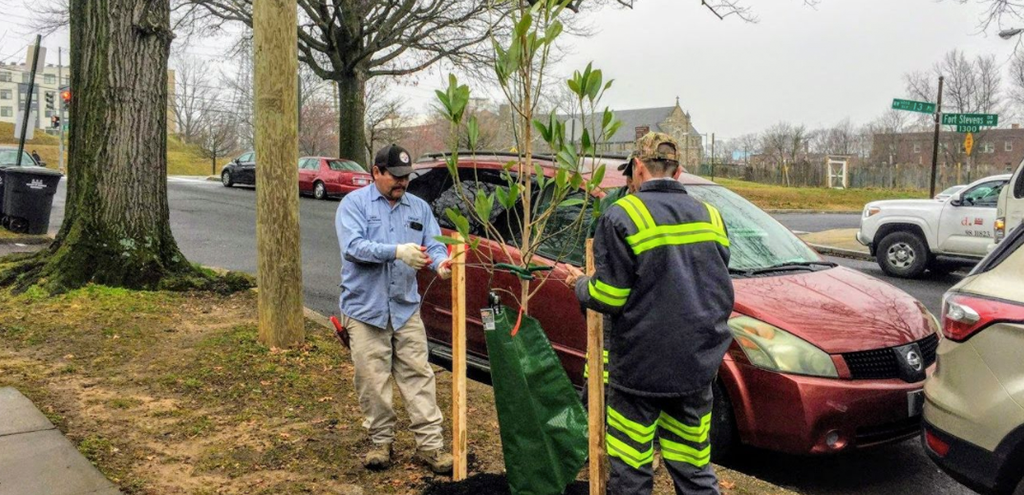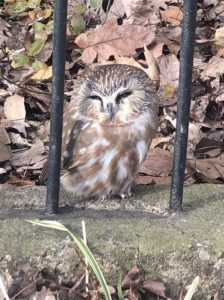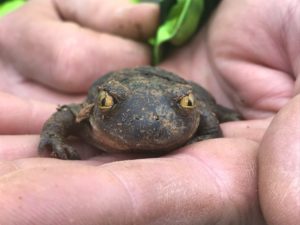THE LEAFLET

Walk on the Wild Side with the Urban Forestry Division
On any given day, District urban foresters may be called upon to inspect an ailing tree, clear a branch from a roadway, or lead planting crews through downtown DC. But some days, even an urban forester can be surprised by what they find in the normal course of their duties. Within the past year District urban foresters have rescued a wayward tiger salamander, a jaunty shorebird, and a migrant owl, all while inspecting an average of 300 trees each day. Here are three short stories that show just how far the Urban Forestry Division (UFD) will go to protect city trees and the wildlife that call them home.
Tiger found in the District

Tiger salamander discovered in root ball of Chinese fringe tree (Courtesy of UFD/DDOT).
Late in 2019 Urban Forester Sam Doan was leading a planting crew through Ward 7, making sure trees were planted at the proper height and placed just right between street signs and overhead wires. Next up was a Chinese fringe tree, wrapped in burlap, a common practice to keep roots intact for the trip from the tree farm to its final planting destination. However, this fringe tree was carrying more than soil, and unwrapping the burlap revealed an 8-inch-long tiger salamander.
Aware that tiger salamanders are endangered in the Chesapeake Bay Region, Sam did a little sleuthing into the salamander’s background. The salamander had unknowingly hitchhiked in the roots of the fringe tree all the way from its home in Cookville, Tennessee. Not wanting to release it locally due to the risk of spreading disease to local amphibians, Sam made arrangements with the Tennessee Wildlife Resources Agency to drop off the salamander while taking a family road trip to Great Smoky Mountains National Park. Sam and his family drove 575 miles and one time zone to drop off the tiger salamander with non-game wildlife experts, who would release it back into the wild, close to its original home in Tennessee.
Close to home
Mornings with the District Department of Transportation’s (DDOT) Urban Forestry Division usually means a trip to the parking garage with gear and coffee to pick up a work truck or bicycle and head out to the field. In early March of 2020, Urban Forester Matt Lehtonen made the usual trip down to his truck and noticed something hiding in a dark corner of the parking garage, a strange bird. This avian interloper was not the typical kind you find in a parking garage, like a sparrow, but was slightly bigger, about the size of a robin, with mottled brown feathers and an outsized beak. Matt had discovered a common forest-dwelling bird in the Chesapeake Bay, the American woodcock, taking refuge on the second floor of DDOT’s parking garage. The bird, also known as a “timberdoodle”, scurried away, prompting Matt to call for assistance from co-workers to relocate the bird. Within minutes several urban foresters arrived, ready to help. They fanned out searching for the bird and quickly cornered it. Using an insect net, they captured the bird and gently transferred it to a cardboard box, lined with Washington Nationals rally towels.

Releasing the woodcock into Pope Branch Park (Courtesy of UFD/DDOT).
Lucky for the woodcock, it had been captured by an ensemble of urban foresters with intimate knowledge of woods in the District. After an in-depth discussion, they agreed that the nearby Pope Branch Park in Ward 7 would be a perfect spot for the bird. Pope Branch Park had plenty of forested habitat, was within 2.5 miles of DDOT headquarters, and its wetland meadow was recently restored by the Department of Energy and the Environment (DOEE). A small group of urban foresters released the woodcock into the meadow, where it promptly shuffled over to the water’s edge to grab a quick drink. Soon after the bird moved further away among newly planted trees, poking its beak into the grass, probing for earthworms, all the while showing off its characteristic timberdoodle strut.
New Years Eve Bird Count
Early on New Years Eve, Ward 8 Urban Forester Carlson Klapthor got an emergency call from a neighbor in Capitol Hill. The neighbor had discovered a small owl in the front yard of his rowhouse. Carlson investigated it and judging from its sluggishness and unresponsiveness decided to call for backup. City Wildlife showed up within 30 minutes and rescued the owl. In the meantime, Urban Forestry had reached out to DOEE Ornithologist Dan Rauch to find out more about the diminutive owl. Dan Rauch confirmed from the photo that Carlson had encountered a saw-whet owl. This owl species prefers mature forests and migrates to southern locales for the winter, which likely explains its presence in the District.

Saw-whet owl spotted in Capitol Hill. City Wildlife arrived quickly to rescue the owl (Courtesy of UFD/DDOT).
Unfortunately, City Wildlife reported that the owl, a female, had sustained injuries, which she did not survive, an unfortunate end for the winter migrant. Saw-whet owls are normally quite secretive, which makes them challenging to capture in bird counts, but not in 2020. In fact, this late observation on New Year’s Eve put 2020 over the top as one of the second highest bird counts on record at 246 bird species sighted in DC, according to Rauch. If you aren’t lucky enough to live near a District urban forester, please take the extra step to report wildlife in distress to the Humane Rescue Alliance Wildlife (202-723-5730) or City Wildlife (202-882-1000).

Spadefood toad discovered in root ball of honeylocust during tree planting. (Courtesy of UFD/DDOT).
Each day urban foresters are out and about in DC, caring for city trees and responding to resident service requests. Along the way they may be called on to clear snow from the Met Branch Trail, capture a bee swarm, or lend a helping hand to a lost toad. It’s the nature of urban forestry, never predictable, and always a bit wild. Next time you are out for a walk or ride in DC and encounter someone in a high-vis vest, with a mask and tablet, peering up at a tree, they just might be a District Urban Forester. Feel free to stop and say hello, from a distance of course. We are here to help.
Article photo via DDOT’s Twitter.